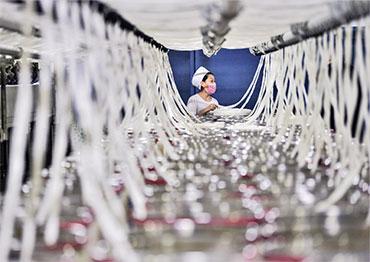Along with the mounting orders for textile products come skyrocketing freight prices and over-demand for shipping containers.
“In October 2020, the price of a 40-foot container to Europe was stable at around US$3,000, even dropping to around US$2,000. Prices have gone up since then,” a source from a Chinese freight company told the reporter. “Prices reached US$4,700 by November, and even US$7,500 to US$7,700 by mid-December.”
Shipping costs to the US began to rise in September 2020, which coincided with orders returning to China. “Before that, it cost over US$2,000 a container from China to the US. Now the prices are US$6,000, and they’re still going up.”
On New Year’s Eve 2020, the China Containerized Freight Index (CCFI), which measures changes in spot freight rates, based on shipping rates and volumes of 12 major routes, hit a record high of 1,658.58. Five months earlier, the index was 65.55. Container shortages were behind the price increase. “Containers have been hard to get since late November 2020,” the freight company agent said. “Lack of containers caused warehouse overstock.”
In October 2020, the Port of Los Angeles experienced the busiest month in its 113-year history, handling more than 980,000 TEUs (Twenty-Foot Equivalent Units, a standardized maritime industry measurement used to count cargo containers of different lengths.)
The most challenging situation is that shipping capacity has not returned to prepandemic levels, while exports are greater than normal. “Many routes that had three ships in operation now only have one,” said the freight agency source. “In Q2 2020, there was nothing for freight companies to ship. Now the price increases aim to make up for previous losses, which is understandable,” he said.
However, the price hikes in freight have impacted textile exports. “It’s been terrible. It’s been eating into profits,” Yan Liangmin, head of logistics at a textile company, told NewsChina. “Textiles take up more space, but the added value of one container of textile products is not high. A container of machinery and equipment could be valued in the hundreds of thousands of dollars, but the value of a container of textiles is only around US$30,000,” Yan said.
Fluctuations in currency exchanges are also to blame. Appreciation of the Chinese yuan cut into H2 2020 profits by seven or eight points while competing manufacturers in countries such as Turkey saw their currencies depreciate, giving them an advantage. In the last three years, the Turkish lira depreciated three points against the US dollar to 7.8, while the yuan increased to 6.5 against the dollar over the same period.
Profits have been largely swallowed up by rising shipping costs and the appreciation of the yuan. Facing additional pressures, such as rising cotton prices, Chinese textile companies are operating at increasingly narrow margins.

 Old Version
Old Version
